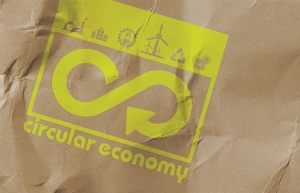Pathways aplenty for Vietnam’s circular economy transition
These ambitions reflect the country’s commitment to sustainable development and the wellbeing of its people.
To achieve these goals, Vietnam will need to overcome significant challenges. Waste, air and plastic pollution, including in beautiful Hanoi, remind us of the difficulty in balancing rapid economic growth and environmental protection. The circular economy offers a powerful opportunity to address these challenges. But we must act fast, transitioning rapidly from planning to action.
 |
| Ramla Khalidi. resident representative in Vietnam United Nations Development Programme |
The United Nations Development Programme is a longstanding advocate for sustainable development, and we have developed a vision to advance a transformative agenda for a low-carbon and inclusive circular economy. At the heart of this vision is integration. To make the circular economy a reality, we must treat it not as a standalone concept but as a holistic, integrated approach that touches every aspect of the economy and society.
There are four key pathways proposed to accelerate Vietnam’s transition to a circular economy. Firstly, we must integrate eco-design into policies. Evidence-based policies are the key to supporting the transition to a circular economy.
Vietnam’s extended producer responsibility framework offers a strong foundation. However, implementation gaps remain. For example, it is essential to encourage businesses to actively engage in these efforts, rather than merely contributing funds to the government.
Global good practices, including the EU’s sustainable eco-design product regulations, show how legislation can drive innovation. Vietnam today can lead the innovation agenda by embedding eco-design into its circular economy roadmap, setting measurable targets for recycled content, product lifespan, and energy efficiency. Such measures would not only align Vietnam with global sustainability standards but promote competitiveness.
Secondly, we should prioritise key sectors for integrating circular practices. Vietnam’s growth is closely tied to international trade, and policies like the EU’s Carbon Border Adjustment Mechanism may impact export oriented industries such as aquaculture, coffee production and fruit farming.
Yet, many businesses are not yet fully prepared to meet such strict environmental standards. This is where the transformative power of circular economy practices can make a difference, allowing some sectors a competitive edge.
Vietnam should prioritise sectors closely linked to trade. Sectors such as agriculture, electronics, plastics, textiles, and construction materials. By prioritising these sectors, Vietnam can align with international standards and unlock opportunities for sustainable growth and long-term resilience.
Thirdly, the circular transition should be embedded within current institutional reforms In the words of Party General Secretary To Lam “institutions remain the bottleneck of bottlenecks, hampering the country’s development. Profound reforms are critical for fostering innovation and driving change”.
In the context of the circular economy, streamlining governance frameworks and regulatory processes is key. For instance, simplifying procedures for reusing treated wastewater and addressing the cost disparities between virgin and recycled plastics can unlock opportunities.
This requires coordinated efforts across ministries. Effective institutions and streamlined governance structures can enhance cross-sectoral collaboration, reduce bureaucratic barriers, and create an environment that fosters innovation - an essential driver for the circular economy.
Last, but not least, transition to a circular economy is a whole of society endeavour. Vietnam must continue to place people and social equity at the center of the circular transition to ensure it is both just and inclusive. It must also continue to create opportunities for multi-sector and multi-stakeholder dialogues that promote whole of society buy-in and ownership.
Partnerships like the National Plastic Action Partnership and the Vietnam Circular Economy Hub present opportunities to transform the vision for circular economy transition into action.
We are ready to support Vietnam in prioritising reforms that create a supportive ecosystem for transformation. We aim to support the country’s transition to a greener, circular, and low-carbon economy, delivering multiple benefits for sustainable development.
 | Driving a circular transition in Vietnam’s agriculture The circular economy has gained momentum in the agriculture sector because it can deliver a myriad of benefits. I would like to highlight its impact on climate goals, economic competitiveness, and protecting human and ecosystem health. |
 | Competition focuses on fostering circular economy More than just a competition, “Plastic Circular Innovation Solutions 2024” held in Hanoi on October 22 brings many superior solutions to the journey of combating plastic waste in Vietnam. |
 | Coordination key for circular economy Boosting the circular economy and green transformation need to be a key driving force for society, but this requires more incentives on taxes, fees, and incentives. |
What the stars mean:
★ Poor ★ ★ Promising ★★★ Good ★★★★ Very good ★★★★★ Exceptional
Related Contents
Latest News
More News
- Vietnam's top 500 value-creating enterprises announced (December 27, 2025 | 08:00)
- The PAN Group shaping a better future with ESG strategy (December 26, 2025 | 09:00)
- Masan Consumer officially lists on HSX, marking the next phase of value creation (December 25, 2025 | 13:20)
- MCH to become the largest consumer stock on VN-Index (December 24, 2025 | 11:05)
- Oil and gas firms post strong 2025 results (December 22, 2025 | 17:42)
- SABECO wins multiple international beer awards (December 22, 2025 | 17:41)
- UOB sees Vietnam growth easing in fourth quarter (December 22, 2025 | 17:39)
- First members of Danang International Finance Centre revealed (December 22, 2025 | 17:39)
- Human-centred governance seen as key to AI development (December 19, 2025 | 18:19)
- Top 10 notable events of Vietnam’s industry and trade sector in 2025 (December 19, 2025 | 14:00)

 Tag:
Tag:





















 Mobile Version
Mobile Version